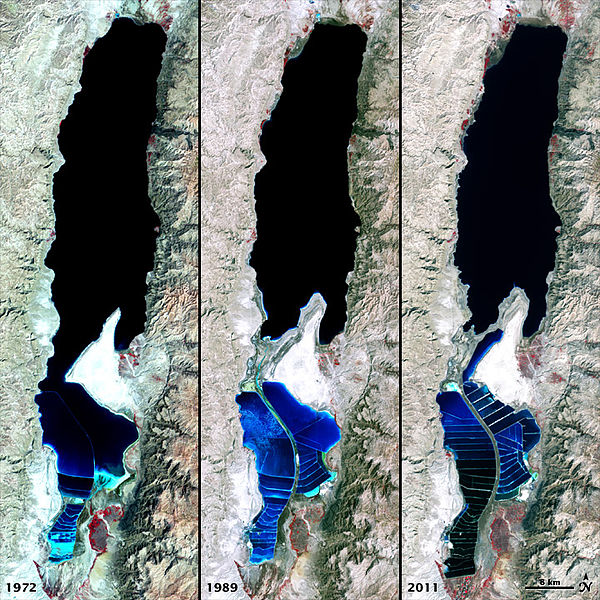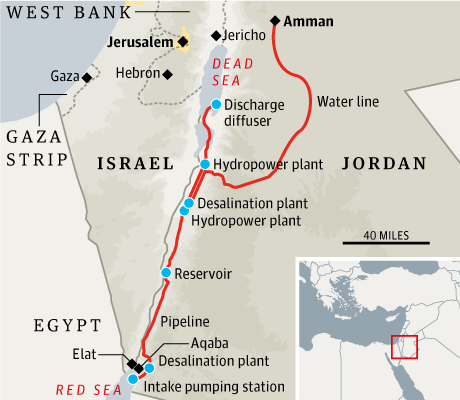Blue Peace: Red Sea-Dead Sea Pipeline Plan Signed
Israel, Jordan and the Palestinian Authority signed trilateral Red Sea-Dead Sea pipeline plan on Dec. 9th 2013, at the headquarters of the World Bank. The ambitious and contested  project
aims to replenish the rapidly shrinking Dead Sea by transferring in
water from the Red Sea along a 110-mile (180 km long) pipeline. The
pipeline will channel 100 million cubic meters of water per annum
northward from the Red Sea and will cost an estimated $300-400 million. A
BOT tender for the project will be published in 2014. The pipeline will
take an estimated three years to complete. The inflow of water from the
Red Sea will slow the drying up of the Dead Sea and its concomitant
negative effects.
project
aims to replenish the rapidly shrinking Dead Sea by transferring in
water from the Red Sea along a 110-mile (180 km long) pipeline. The
pipeline will channel 100 million cubic meters of water per annum
northward from the Red Sea and will cost an estimated $300-400 million. A
BOT tender for the project will be published in 2014. The pipeline will
take an estimated three years to complete. The inflow of water from the
Red Sea will slow the drying up of the Dead Sea and its concomitant
negative effects.
Israel's
energy and infrastructure minister, Silvan Shalom, said it was "a
historic agreement that realises a dream of many years... [and] is of
the highest diplomatic, economic, environmental and strategic
importance." He and the Palestinian and Jordanian water ministers,
Shaddad Attili and Hazem al-Nasser, attended a signing ceremony in
Washington. project
aims to replenish the rapidly shrinking Dead Sea by transferring in
water from the Red Sea along a 110-mile (180 km long) pipeline. The
pipeline will channel 100 million cubic meters of water per annum
northward from the Red Sea and will cost an estimated $300-400 million. A
BOT tender for the project will be published in 2014. The pipeline will
take an estimated three years to complete. The inflow of water from the
Red Sea will slow the drying up of the Dead Sea and its concomitant
negative effects.
project
aims to replenish the rapidly shrinking Dead Sea by transferring in
water from the Red Sea along a 110-mile (180 km long) pipeline. The
pipeline will channel 100 million cubic meters of water per annum
northward from the Red Sea and will cost an estimated $300-400 million. A
BOT tender for the project will be published in 2014. The pipeline will
take an estimated three years to complete. The inflow of water from the
Red Sea will slow the drying up of the Dead Sea and its concomitant
negative effects.
Located
in the Jordan rift valley bordering Jordan to the east, and Israel and
Palestine to the west, the Dead Sea is served only by the Jordan River
to the North. The water level in the Dead Sea dropped from 390 metres
below sea level in the 1960s to 420 metres below sea level at present
and will be 450 metres below sea level by 2040. The water surface area
has shrunk by a third, from 950 square kilometres to 637 square
kilometres.
 A
combination of the mineral content of the water, low content of
pollens, the reduced ultraviolet component of solar radiation and the
higher atmospheric pressure at this depth have specific health effects
which have borne a booming spa-tourism economy. This along with the
dramatic scenery and tranquil waters is why it has long been a site of
tourism and refuge; King David used it as such and it was one of the
world’s first health resorts for Herod the Great.
A
combination of the mineral content of the water, low content of
pollens, the reduced ultraviolet component of solar radiation and the
higher atmospheric pressure at this depth have specific health effects
which have borne a booming spa-tourism economy. This along with the
dramatic scenery and tranquil waters is why it has long been a site of
tourism and refuge; King David used it as such and it was one of the
world’s first health resorts for Herod the Great.
Red Sea-Dead Sea Pipeline Plan
According
the agreed plan of pumping water from the one sea to the other – a
project known as the Red-Dead Conduit, or Two Seas Canal – will help to
slow the dessication of the Dead Sea, which is famous for its high
levels of salt and other minerals that allow bathers to float on its
surface. "The inflow of water from the Red Sea will slow the drying up
of the Dead Sea," said the Israeli government. Approximately 200 million
cubic meters of water will be drawn per annum. Around 80 million cubic
meters will be desalinated at a facility to be built in Aqaba facility
with Israel receiving 30-50 million cubic meters of water for the Arava
region and Eilat, and with Jordan receiving 30 million cubic meters of
water for use in the south. Israel will also sell Jordan another 50
million cubic meters of water from the Kinneret for use in the north.
The other goals of this project are the generation of electricity by
utilizing the difference in elevation between the Red Sea and the Dead
Sea and the development of tourism infrastructures.

- Red Sea - Dead Sea Pipeline. Images courtesy of ESA.
While the plan is accepted by respective international authorities there is also critics inside Israeli regime. Regional environmental group Friends of the Earth Middle East and the Environmental Protection Ministry have slammed the plan
as destructive to the very sea that it aims to save. The Environmental
Protection Ministry likewise announced its rejection of the Red-Dead
program, stressing that without more informed data and experimentation,
such a plan cannot proceed. Citing experts from the Geological Survey of
Israel, the ministry said that pumping more than 350 million cubic
meters of seawater and brine to the Dead Sea could lead to an outbreak
of bacteria and algal growth, causing disturbing odors in the region. Some
environmentalists argue that the introduction of Red Sea water
containing living organisms could have a catastrophic effect on the
unique characteristics of the Dead Sea.

Blue Peace
The Red-Sea-Dead-Sea pipeline in one of the key recommendations advocated in a report Blue Peace: Rethinking Middle East Water. As water resources in the Middle East should be considered as a potential source of socioeconomic development and peace, a group of independent Indian experts, the Strategic Foresight Group (SFG), was mandated by Switzerland and Sweden - the Swiss Agency for Development Cooperation and the Swedish International Development Cooperation Agency - to flank a process of reflection on this issue on 2009. A series of consultations and meetings took place in 2010, i.e., in Montreux (Switzerland), in Amman (Jordan), and in Sanliurfa (Turkey). The SFG then drew up the “Blue Peace” report based on these consultations, which in end effect brought together a good hundred of experts and leaders from the Middle East. On February 2011 the report was presented in Geneva.The report, prepared with support and input from almost 100 leaders and experts from Israel, the Palestine Territories, Jordan, Lebanon, Syria, Iraq and Turkey, also stated that water crisis can be converted into an opportunity for regional peace.

More about Blue Peace in "The Blue Peace - Rethinking Middle East Water: Complete report" Download (PDF, 3128 KB) :

Comments